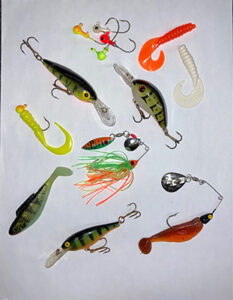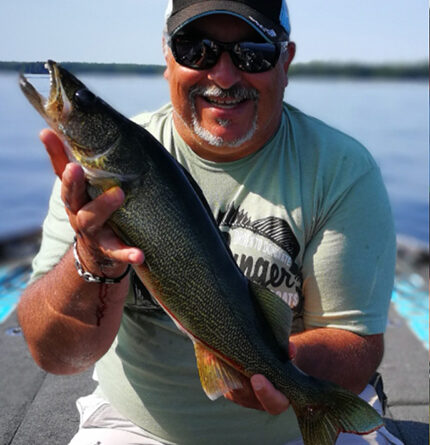Living Gold
Every Spring a gold rush occurs across Ontario, but it’s not for the precious metal that first comes to mind. This gold swims and is native to many of our freshwater lakes and rivers; I am talking about Sander Vitreus aka the Walleye. 
Walleye, or Pickerel as it is commonly referred to in Canada, are the largest member of the Perch family and arguably one of the best tasting fish Ontario has to offer.
For those anglers wanting to target these tasty fish, Ontario’s cottage country offers some of the best opportunities for success.
There are some key points to keep in mind when targeting Walleye in the spring, so follow along as I pave your way to gold!
• By far, the most important thing I look for when guiding my clients is what I’ll call “dirty water”. This does not refer to the cleanliness of the water but rather the colour of it. Spring runoff can cause many of the small creeks and rivers entering larger water bodies to become muddy or murky. The suspended particles of debris affect how much sunlight penetrates the water and when you’re talking about Walleye fishing, less is more. Walleyes have very large opaque looking eyes resulting from a special reflecting area on their retinas. This specialized feature allows them to see better in low light conditions and ultimately this results in better feeding opportunities over other gamefish. Dirty water can also be the result of waves crashing against a shoreline due to strong winds or boat traffic. Even the effects of other fish congregating to spawn such as Carp can muddy up the water. Whatever the reason, dirty water is one of the ingredients to locating early season Walleye.
• Although Walleye are primarily thought of as a cold, deep water dweller, early season will find them roaming the shallows as springtime water temperatures have not forced them to seek cooler temperatures. These shallow waters, in the range of 2 to 6 feet of depth, are also a magnet in the spring for many panfish such as Perch, Rock Bass and Sunfish, all of which are on the hungry Walleye’s menu. When fishing these shallow water areas, I look for any new weed growth. Typically, green weed will attract Walleye more than old dead weed, but in some cases both can be equally productive. Submerged trees and logs as well as gravel and rocks can also be good areas to investigate.
• In lakes where finding muddy or murky water is a challenge, I concentrate my efforts on slightly deeper water and prefer to fish areas where there is a combination of rock and weed. Try to key in on water with depths of 6 to 10 feet and look for large boulders or gravel deposits amongst the weed clumps that might provide a Walleye an advantage to ambush unwary baitfish. Night fishing for Walleye on these clear water lakes can provide some of the best action, but I would recommend this only to experienced boaters who are familiar with the lake and have all the necessary safety and navigation equipment.
When it comes to tackle, I prefer to use a medium action 6 1/2-to-7-foot spinning rod, spooled with an 8-to-10-pound test line. Braided line tied directly to your lure is fine if the water is dirty but add a fluorocarbon or monofilament leader when fishing in clearer conditions.
My lure choices for this time of year tend to run a bit smaller than if I were to target Walleye in the fall. A simple ball head jig tipped with a plastic curly tailed grub can catch them in almost any situation, try using colours such as white, yellow, or orange. Crankbaits with diving depths of 2 to 8 feet in a Perch pattern, or similar colour scheme are a definite must have. Try varying the speed of your retrieve, often a slow steady speed is better than an erratic stop and go, especially in dirty water where it might take Walleye a bit longer to key in on your lure. Small spinnerbaits or in-line spinners with a single hook are very effective in heavier weed growth and can be tipped with a plastic grub if desired.
Walleye fishing can be a fun and rewarding part of your early season angling adventures, however, they are a heavily regulated sportfish in Ontario, largely due to their popularity among anglers.
Please be sure to consult the Ontario fishing regulations for information on any special restrictions pertaining to the area you are fishing.
Good luck and get outside!
Mike Quesnelle,
Goat Angling Adventures




